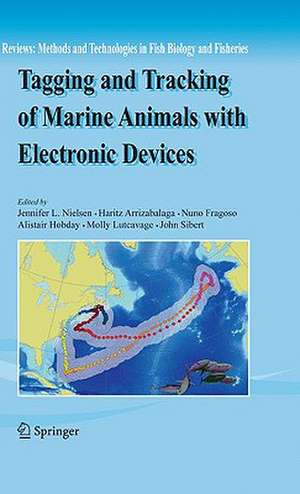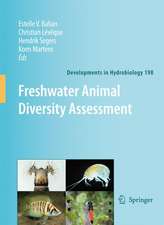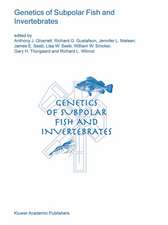Tagging and Tracking of Marine Animals with Electronic Devices: Reviews: Methods and Technologies in Fish Biology and Fisheries, cartea 9
Editat de Jennifer L. Nielsen, Haritz Arrizabalaga, Nuno Fragoso, Alistair Hobday, Molly Lutcavage, John Siberten Limba Engleză Hardback – 18 iun 2009
Papers in this volume are divided into three sections, the first describing insights into behavior achieved using acoustic, archival, and novel tags, the second reporting on advances in methods of geolocation, while the final section includes contributions where tag data have been used in management of marine species. Accurate documentation of animal movements and behaviors in critical marine habitats are impossible to obtain with other technologies. The management and conservation of marine species are critical in today’s changing ocean environment and as electronic tags become more accurate and functional for a diversity of organisms their application continues to grow, setting new standards in science and technology.
| Toate formatele și edițiile | Preț | Express |
|---|---|---|
| Paperback (1) | 1225.48 lei 6-8 săpt. | |
| SPRINGER NETHERLANDS – 28 oct 2010 | 1225.48 lei 6-8 săpt. | |
| Hardback (1) | 1234.62 lei 6-8 săpt. | |
| SPRINGER NETHERLANDS – 18 iun 2009 | 1234.62 lei 6-8 săpt. |
Preț: 1234.62 lei
Preț vechi: 1505.64 lei
-18% Nou
Puncte Express: 1852
Preț estimativ în valută:
236.27€ • 256.56$ • 198.47£
236.27€ • 256.56$ • 198.47£
Carte tipărită la comandă
Livrare economică 22 aprilie-06 mai
Preluare comenzi: 021 569.72.76
Specificații
ISBN-13: 9781402096396
ISBN-10: 1402096399
Pagini: 480
Ilustrații: XXVI, 452 p.
Dimensiuni: 155 x 235 x 31 mm
Greutate: 0.93 kg
Ediția:2009
Editura: SPRINGER NETHERLANDS
Colecția Springer
Seria Reviews: Methods and Technologies in Fish Biology and Fisheries
Locul publicării:Dordrecht, Netherlands
ISBN-10: 1402096399
Pagini: 480
Ilustrații: XXVI, 452 p.
Dimensiuni: 155 x 235 x 31 mm
Greutate: 0.93 kg
Ediția:2009
Editura: SPRINGER NETHERLANDS
Colecția Springer
Seria Reviews: Methods and Technologies in Fish Biology and Fisheries
Locul publicării:Dordrecht, Netherlands
Public țintă
ResearchCuprins
Behavioural Insights Based on the Use of Electronic Tags.- Using Telemetry to Monitor Movements and Habitat Use of Cultured and Wild Juvenile Winter Flounder in a Shallow Estuary.- Comparative Behavior of Wild and Hatchery Reared White Sea Bream (Diplodus sargus) Released on Artificial Reefs Off the Algarve (Southern Portugal).- Survival, Migration Speed and Swimming Depth of Atlantic Salmon Kelts During Sea Entry and Fjord Migration.- Small Scale Vertical Behaviour of Juvenile Albacore in Relation to Their Biotic Environment in the Bay of Biscay.- A Review of Acoustic Telemetry Technology and a Perspective on its Diversification Relative to Coastal Tracking Arrays.- The Ocean Tracking Network – Adding Marine Animal Movements to the Global Ocean Observing System.- Observations of the Behaviour of European Sea Bass (Dicentrarchus labrax) in the North Sea.- Vertical Movements and Habitat Utilization of Skipjack (Katsuwonus pelamis), Yellowfin (Thunnus albacares), and Bigeye (Thunnus obesus) Tunas in the Equatorial Eastern Pacific Ocean, Ascertained Through Archival Tag Data.- Investigations of Horizontal Movements of Atlantic Swordfish Using Pop-up Satellite Archival Tags.- Vertical Behavior and the Observation of FAD Effects on Tropical Tuna in the Warm-Pool of the Western Pacific Ocean.- Effects of T-bar and DST Tagging on Survival and Growth of European Hake.- Body Temperature of the Atlantic Bluefin Tuna (Thunnus thynnus L.) in the Western Mediterranean.- Multi-Channel Data-Logging: Towards Determination of Behaviour and Metabolic Rate in Free-Swimming Sharks.- Harnessing the Sun: Testing a Novel Attachment Method to Record Fine Scale Movements in Ocean Sunfish (Mola mola).- An Archival Tag for Monitoring Key Behaviours (Feeding and Spawning) in Fish.- GeolocationMethods.- Lessons from a Prototype Geolocation Problem.- Geolocating Fish Using Hidden Markov Models and Data Storage Tags.- State Space Model for Light Based Tracking of Marine Animals: Validation on Swimming and Diving Creatures.- Removing Bias in Latitude Estimated from Solar Irradiance Time Series.- Positioning Pelagic Fish from Sunrise and Sunset Times: Complex Observation Errors Call for Constrained, Robust Modeling.- Summary Report of aWorkshop on Geolocation Methods for Marine Animals.- Applications of Electronic Tags to Fisheries Management.- Developing Integrated Database Systems for the Management of Electronic Tagging Data.- Electronic Tagging Data Supporting Flexible Spatial Management in an Australian Longline Fishery.- Correction Factors Derived from Acoustic Tag Data for a Juvenile Southern Bluefin Tuna Abundance Index in SouthernWestern Australia.- A Multi-Scale Study of Red Porgy Movements and Habitat Use, and Its Application to the Design of Marine Reserve Networks.- Erratum.
Recenzii
From the reviews:
“The book is a collection of 25 papers submitted by attendees of the 2nd International Tagging and Tracking Symposium held in Spain in late 2007. … Overall, this is a book for researchers and resource managers to find out what is being achieved with commercial tags. It is also a great way to catch up on what is new in a field which has seen a lot of activity in the last decade.” (Mark Johnson, Aquatic Mammals, Vol. 37 (2), 2011)
“The book is a collection of 25 papers submitted by attendees of the 2nd International Tagging and Tracking Symposium held in Spain in late 2007. … Overall, this is a book for researchers and resource managers to find out what is being achieved with commercial tags. It is also a great way to catch up on what is new in a field which has seen a lot of activity in the last decade.” (Mark Johnson, Aquatic Mammals, Vol. 37 (2), 2011)
Textul de pe ultima copertă
The 2nd international tagging and tracking symposium was held in San Sebastian, Spain, in October 2007, seven years after the first symposium was held in Hawaii in 2000 (Sibert and Nielsen 2001). In the intervening seven years, there have been major advances in both the capability and reliability of electronic tags and analytical approaches for geolocation of tagged animals in marine habitats. Advances such as increased data storage capacity, sensor development, and tag miniaturization have allowed researchers to track a much wider array of marine animals, not just large and charismatic species. Importantly, data returned by these tags are now being used in population analyses and movement simulations that can be directly utilized in stock assessments and other management applications. Papers in this volume are divided into three sections, the first describing insights in behavior achieved using acoustic, archival, and novel tags, the second reporting on advances in methods of geolocation, while the final section includes contributions where tag data have been used in management of marine species. Accurate documentation of animal movements and behaviors in critical marine habitats are impossible to obtain with other technologies. The management and conservation of marine species are critical in today’s changing ocean environment and as electronic tags become more accurate and functional for a diversity of organisms their application continues to grow, setting new standards in science and technology.
Caracteristici
Exciting developments in new tagging applications in marine animals New analyses of geolocation techniques using remote tags New documentation of animal behaviour in marine habitats Long distance marine species migrations Hatchery and wild fish behavior at sea































